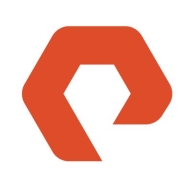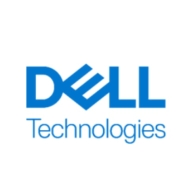


Find out what your peers are saying about Dell Technologies, NetApp, Pure Storage and others in All-Flash Storage.



Pure Storage FlashArray//X is the world’s first enterprise-class, all-NVMe flash storage array. It represents a new class of storage – shared accelerated storage, which is a term coined by Gartner – that delivers major breakthroughs in performance, simplicity, and consolidation.
Dell EMC Unity XT is one of the best all-flash storage arrays on the market today. Dell EMC Unity XT arrays are designed for performance, optimized for efficiency, and built for a multi-cloud world. In addition, they support digital transformation, enabling businesses to reach the full potential of their data capital quickly and easily. Dell EMC Unity’s All-Flash and Hybrid Flash storage platforms provide the performance, efficiency, enterprise-class software, and virtualization integrations required for running a wide range of virtualized applications.
Dell EMC Unity XT Features
Dell EMC Unity XT has many valuable key features, including:
Dell EMC Unity XT Benefits
Some of the benefits of using Dell EMC Unity XT include:
Reviews from Real Users
Below are some reviews and helpful feedback written by Dell EMC Unity XT users.
A Systems Engineering Manager at a manufacturing company says, "It is definitely one of the most robust, solid, well-performing products that I have dealt with. It is set it and forget it, which is pretty amazing." He also mentions, “We can do both block and file storage on one unit without purchasing a separate device.”
Peter S., Senior Technical Specialist at a healthcare company, states, “The most valuable feature is reliability. At the end of the day, it just runs. This solution is easy to work with and easy to maintain.”
PeerSpot user Melvin T., Senior Systems Engineer at Prosperity Bank, explains that the solution is “easy to use and we can add LUNs or space without interruption to end-users. We're able to access it from just about anywhere, as long as we have access to a browser. That feature is really neat because sometimes we will go to a different data center or a different site, and if we need to access it to see a LUN or to see any type of storage, we can do that. That's one of the big takeaways with Unity."
VMware vSAN is a software-defined storage product that is used in collaboration with VMware ESXi hypervisor and that provisions and manages storage based on policies, regardless of the underlying hardware. The solution enables you to prime your business for growth through its seamless evolution (it is integrated with vSphere and requires no new tools), its flexibility, and its multi-cloud capabilities. As an industry-leading software, VMware vSAN provides high levels of performance with minimal impact on CPU and memory.
VMware vSAN Features
VMware vSAN has many valuable key features. Some of the most useful ones include:
VMware vSAN Benefits
There are many benefits to implementing VMware vSAN. Some of the biggest advantages the solution offers include:
Reviews from Real Users
Below are some reviews and helpful feedback written by PeerSpot users currently using the VMware vSAN solution.
PeerSpot user Yves S., CEO, Cloud Evangelist at Comdivision Consulting GmbH, says, “vSAN gives us a lot of advantages when we need to expand resources. We have an overall larger host infrastructure, and we split that up for specific customer test and use cases. In that specific scenario, we can easily add more hosts or reduce the number of hosts in the environment.”
A reviewer who works in Infrastructure Security explains, “The ease of use is great. The initial setup and upgrade process was pretty straightforward. And, technical support is great.”
Laurent N., Director at Softlogic, comments, "The feature that I have found most valuable is that it is easy to deploy. It is easy to create and delete virtual servers. It is easy to create the load balancing and the clustering."
We monitor all All-Flash Storage reviews to prevent fraudulent reviews and keep review quality high. We do not post reviews by company employees or direct competitors. We validate each review for authenticity via cross-reference with LinkedIn, and personal follow-up with the reviewer when necessary.